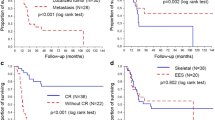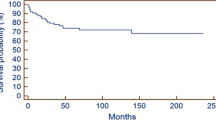Abstract
Background
The purpose of this study is to assess the outcome of patients with Ewing sarcoma (EWS) of the bone and to identify prognostic factors.
Materials and methods
Seventy-seven patients younger than 18 years old, diagnosed with EWS of the bone between 1979 and 2009, were analysed retrospectively. Four different protocols of chemotherapy were used successively. Local treatment consisted of surgery (N=32), radiotherapy (N=20) and a combination of both (N=19).
Results
The median age at diagnosis was 10 years old (range, 2–17) and the median follow-up for survivors 8.6 years (range, 1–18.8). Thirty-two relapses occurred (21 distant, 5 local and 6 both). The 2- and 5-year overall survival rates were 70% and 51%, respectively. Multivariate analysis showed four significant independent predictors for death: age ≥14 years old (HR: 5.06; p=0.019), lack of complete response (HR: 8.04; p<0.001), tumour volume ≥150 ml (HR: 2.21; p=0.045) and distant recurrences (HR: 1.45; p=0.001).
Conclusions
Outcome of EWS of bone is influenced by many clinical and treatment-correlated variables. Criteria to stratify patients should include all the variables that have shown prognostic significance. The development of novel therapies should target these high-risk groups.
Similar content being viewed by others
References
de Alava E (2007) Molecular pathology in sarcomas. Clin Transl Oncol 9:130–144
Rodriguez-Galindo C, Liu T, Krasin MJ et al (2007) Analysis of prognostic factors in ewing sarcoma family of tumors: review of St. Jude Children’s Research Hospital studies. Cancer 110:375–384
Bernstein M, Kovar H, Paulussen M et al (2005) Ewing sarcoma family of tumors: Ewing sarcoma of bone and soft tissue and the peripheral primitive neuroectodermal tumors. In: Pizzo P, Poplack D (eds) Principles and practice of pediatric oncology, 5th edn. Lippincott Williams and Wilkins, Philadelphia, pp 1002–1032
Peris-Bonet R (2008) Incidencia y supervivencia del cancer infantil. Rev Esp Pediatr 64:342–356
Craft AW, Paulussen M, Douglas C et al (2000) EICESS 92: early results of an international Ewings tumour study. Med Pediatr Oncol 35:191
Grier HE, Krailo MD, Tarbell NJ et al (2003) Addition of ifosfamide and etoposide to standard chemotherapy for Ewing’s sarcoma and primitive neuroectodermal tumor of bone. N Engl J Med 348:694–701
Rodriguez-Galindo C, Spunt SL, Pappo AS (2003) Treatment of Ewing sarcoma family of tumors: current status and outlook for the future. Med Pediatr Oncol 40:276–287
Cotterill SJ, Ahrens S, Paulussen M et al (2000) Prognostic factors in Ewing’s tumor of bone: analysis of 975 patients from the European Intergroup Cooperative Ewing’s Sarcoma Study Group. J Clin Oncol 18:3108–3114
Miser JS, Goldsby RE, Chen Z et al (2007) Treatment of metastatic Ewing sarcoma/primitive neuroectodermal tumor of bone: evaluation of increasing the dose intensity of chemotherapy-a report from the Children’s Oncology Group. Pediatr Blood Cancer 49:894–900
American Joint Committee on Cancer (2002) Bone. In: Greene FL, Page DL, Fleming ID et al (eds) AJCC cancer staging manual. Springer-Verlag, New York, NY, pp 213–219
Rosen G, Caparros B, Nirenberg A et al (1981) Ewing’s sarcoma: ten-year experience with adjuvant chemotherapy. Cancer 47:2204–2213
Kushner BH, Meyers PA, Gerald WL et al (1995) Very-high-dose short-term chemotherapy for poorrisk peripheral primitive neuroectodermal tumors, including Ewing’s sarcoma, in children and young adults. J Clin Oncol 13:2796–2804
Donaldson SS, Torrey M, Link MP et al (1998) A multidisciplinary study investigating radiotherapy in Ewing’s sarcoma: end results of POG #8346. Pediatric Oncology Group. Int J Radiat Oncol Biol Phys 42:125–135
WHO (1979) Handbook for reporting results of cancer treatment. World Health Organization, Geneva, Offset Publication No. 48
Therasse P, Arbuck SG, Eisenhauer EA et al (2000) New guidelines to evaluate the response to treatment in solid tumors. European Organization for Research and Treatment of Cancer, National Cancer Institute of the United States, National Cancer Institute of Canada. J Natl Cancer Inst 92:205–216
Kaplan EL, Meier P (1958) Nonparametric estimation from incomplete observations. J Am Stat Assoc 53:457–481
Bacci G, Ferrari S, Mercuri M et al (2003) Multimodal therapy for the treatment of nonmetastatic Ewing sarcoma of pelvis. J Pediatr Hematol Oncol 25:118–124
Rodriguez-Galindo C, Navid F, Liu T et al (2008) Prognostic factors for local and distant control in Ewing sarcoma family of tumors. Ann Oncol 19:814–820
Peng RJ, Sun XF, Xiang XJ et al (2009) Efficacy and survival of 92 cases of Ewing’s sarcoma family of tumor initially treated with multidisciplinary therapy. Ai Zheng 28:1304–1309
Yonemori K, Yamaguchi U, Kaneko M et al (2008) Prediction of response and prognostic factors for Ewing family of tumors in a low incidence population. J Cancer Res Clin Oncol 34:389–395
Jurgens H, Exner U, Gadner H et al (1988) Multidisciplinary treatment of primary Ewing’s sarcoma of bone. A 6-year experience of a European Cooperative Trial. Cancer 61:23–32
Paulussen M, Ahrens S, Dunst J et al (2001) Localized Ewing tumor of bone: final results of the cooperative Ewing’s Sarcoma Study CESS 86. J Clin Oncol 19:1818–1829
Bacci G, Ferrari S, Longhi A et al (2003) Therapy and survival after recurrence of Ewing’s tumors: the Rizzoli experience in 195 patients treated with adjuvant and neoadjuvant chemotherapy from 1979 to 1997. Ann Oncol 14:1654–1659
Rodriguez-Galindo C, Billups CA, Kun LE et al (2002) Survival after recurrence of Ewing tumors: the St Jude Children’s Research Hospital experience, 1979–1999. Cancer 94:561–569
Bacci G, Forni C, Longhi A et al (2004) Longterm outcome for patients with non-metastatic Ewing’s sarcoma treated with adjuvant and neoadjuvant chemotherapies. 402 patients treated at Rizzoli between 1972 and 1992. Eur J Cancer 40:73–83
Lee J, Hoang BH, Ziogas A, Zell JA (2010) Analysis of prognostic factors in Ewing sarcoma using a population-based cancer registry. Cancer 116:1964–1973
Shafat I, Ben-Arush MW, Issakov J et al (2010) Preclinical and clinical significance of heparanase in Ewing’s sarcoma. J Cell Mol Med 15:1857–1864
Sari N, Togral G, Cetindag MF et al (2010) Treatment results of the Ewing sarcoma of bone and prognostic factors. Pediatr Blood Cancer 54:19–24
Leavey PJ, Mascarenhas L, Marina N et al (2008) Prognostic factors for patients with Ewing sarcoma (EWS) at first recurrence following multimodality therapy: a report from the Children’s Oncology Group. Pediatr Blood Cancer 51:334–338
Miser JS, Kinsella TJ, Triche TJ et al (1987) Ifosfamide with mesna uroprotection and etoposide: an effective regimen in the treatment of recurrent sarcomas and other tumors of children and young adults. J Clin Oncol 5:1191–1198
Jurgens H, Exner U, Kuhl J et al (1989) High-dose ifosfamide with mesna uroprotection in Ewing’s sarcoma. Cancer Chemother Pharmacol 24[Suppl 1]:S40–44
Pinkerton CR, Rogers H, James C et al (1985) A phase II study of ifosfamide in children with recurrent solid tumours. Cancer Chemother Pharmacol 15:258–262
Author information
Authors and Affiliations
Corresponding author
Rights and permissions
About this article
Cite this article
López Guerra, J.L., Márquez-Vega, C., Ramírez-Villar, G.L. et al. Prognostic factors for overall survival in paediatric patients with Ewing sarcoma of bone treated according to multidisciplinary protocol. Clin Transl Oncol 14, 294–301 (2012). https://doi.org/10.1007/s12094-012-0798-y
Received:
Accepted:
Published:
Issue Date:
DOI: https://doi.org/10.1007/s12094-012-0798-y




